 W
WThe Ain Zada Dam is an embankment dam located 10 km (6 mi) east of Khelil on the Bou-Sellam River in Bordj Bou Arréridj Province, Algeria. Constructed between 1982 and 1986, the primary purpose of the dam is supplying drinking and irrigation water to Sétif, located 24 km (15 mi) to the west.
 W
WThe Al Massira Dam is a gravity dam located 70 kilometres (43 mi) south of Settat on the Oum Er-Rbia River in Settat Province, Morocco. Completed in 1979, the dam provides water for the irrigation of over 100,000 hectares of farmland in the Doukkala region. The dam's hydroelectric power plant also generates 221 gigawatt-hours (800 TJ) on average annually. The power station was commissioned in 1980. Just to the north of the dam is a rip rap saddle dam to support water elevation in the reservoir. The dam's reservoir and wetlands were designated as a Ramsar site in 2005.
 W
WThe Asejire Reservoir is in Oyo State in the south west of Nigeria on the Osun River, about 30 kilometers east of Ibadan. The reservoir was built in the late 1960s. Farming is totally banned in the catchment area, and trees have been planted on the banks, so erosion and silting are not issues. With plentiful water supply, the reservoir remains full throughout the year. The reservoir provides raw water to the Asejire and Osegere water treatment plants in Ibadan. The water supply project was completed in 1972, and has a capacity of about 80 million liters per day, of which 80% is used for domestic purposes.
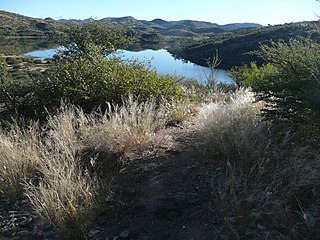 W
WThe Avis Dam is a dam outside of Windhoek, Namibia. It was built in 1933 by the South African colonial authorities. It first flooded in April 1934, but only exceeded 75% again in 2007.
 W
WBagre Dam is a multipurpose dam on the White Volta located near Bagré Village in Burkina Faso.
 W
WThe Banieya Dam is an embankment dam on the Samou River in the Kindia Region of Guinea. It is located 16 km (9.9 mi) west of Kindia. The dam was completed by 1969 for the purpose of water supply. A hydroelectric power station of 5.2 megawatts (7,000 hp) was commissioned at the dam's toe in 1988. The Kale Dam, which also supports a hydroelectric power station, is located downstream.
 W
WBarekese Dam is a dam on the Ofin River that supports the main water treatment plant for Kumasi in the Ashanti Region of Ghana, supplying about 80 percent of the potable water for the city and its surrounding environs. It is operated by the Ghana Water Company.
 W
WThe Bin el Ouidane Dam is an arch dam located 28 kilometres (17 mi) south of Beni Mellal on the El-Abid River in Azilal Province, Morocco. Designed by Coyne et Bellier and constructed between 1949 and 1953, the purpose of the dam is hydroelectric power production and irrigation. Its 135 MW (181,000 hp) power station produces an average of 287 gigawatt-hours (1,030 TJ) annually and water from the reservoir helps irrigate 69,500 hectares in the Beni Moussa and Tadla plains.
 W
WThe Buyo Dam is an embankment dam on the Sassandra River in the Bas-Sassandra district of Côte d'Ivoire. Completed in 1980, it has a hydroelectric power station with an installed capacity of 165 megawatts (221,000 hp), enough to power over 111,000 homes.
 W
WThe Djibloho Dam is a gravity dam on the Wele River near Djibloho in Wele-Nzas, Equatorial Guinea. The primary purpose of the dam is hydroelectric power generation and it supports a 120 megawatts (160,000 hp) power station. Construction on the project began in 2008 and it was inaugurated in October 2012. It is the largest hydroelectric power station in the country. Most of the project's cost was funded by the host government but some funds were provided by the Chinese government. Sinohydro constructed the dam and power station.
 W
WDjorf Torba Dam is a dam in Kenadsa District, Béchar Province, Algeria, crossing the Oued Guir about 50 kilometres (31 mi) west of the capital, Béchar. It is used for the purposes of irrigation and water supply. The area around the head of the dam features a number of notable ancient monuments. The dam has resulted in a significant reduction in the flow of Oued Guir and Oued Saoura in locations downstream of the dam.
 W
WElgaada Dam is one of the water dams on north of Morocco. The elgaada dam is located on the eastern border of the city of fez with an axe machine, with a water vessel of 350.000 cubic metres.
 W
WThe Foum Gleita Dam is an arch dam on the Gorgol River near Foum Gleita in the Gorgol Region of Mauritania. The dam was completed in 1988 with the primary purpose of supplying water for the irrigation of up to 4,000 ha of crops.
 W
WFriedenau Dam is a gravity concrete dam in Khomas Region, Namibia. Located 38 kilometres (24 mi) southwest of Windhoek, it dams the Kuiseb River and provides water to nearby Matchless Mine. It has a capacity of 6.723 million cubic metres (8,793,000 cu yd) and was completed in 1972, when the territory was occupied by South Africa.
 W
WThe Garafiri Dam is an embankment dam on the Konkouré River which forms the boundary between the Kindia and Mamou Regions of Guinea. The dam was constructed by Salini Impregilo between 1995 and 1999 for the purpose of hydroelectric power generation and water supply. The power station had a breakdown in 2002 but was repaired shortly afterwards. The power station has an installed capacity of 75 megawatts (101,000 hp).
 W
WThe Gilgel Gibe I Dam is a rock-filled embankment dam on the Gilgel Gibe River in Ethiopia. It is located about 57 km (35 mi) northeast of Jimma in Oromia Region. The primary purpose of the dam is hydroelectric power production. The Gilgel Gibe I hydroelectric powerplant has an installed capacity of 184 MW, enough to power over 123,200 households. The dam is 1,700 m (5,600 ft) long and 40 m (130 ft) tall. Construction on the dam began in 1988 but work was halted in 1994. In 1995 construction restarted with a new construction firm. The power station was commissioned in 2004.
 W
WGoreangab Dam is a dam in the north-western suburbs of Windhoek, the capital of Namibia. It dams the ephemeral Arebbusch River and its tributary, the Gammams River, which both run across Windhoek. The reservoir behind the dam has a capacity of 3.6 million cubic metres (4,700,000 cu yd).
 W
WThe Grand Poubara Dam is a gravity dam on the Ogooué River, about 15 kilometres (9.3 mi) south of Franceville in Gabon. The primary purpose of the dam is hydroelectric power generation and it supports a 160 megawatts (210,000 hp) power station.
 W
WThe Hassan I Dam is an embankment dam located 19 kilometres (12 mi) northeast of Demnate on the Lakhdar River in Azilal Province, Morocco. Completed in 1986, the dam provides water for the irrigation of over 40,000 hectares of farmland. The dam's hydroelectric power plant also generates 132 gigawatt-hours (480 TJ) on average annually. At 145 metres (476 ft) in height, it is the tallest dam in Morocco and the tallest earth-fill dam in Africa. The dam is named after Hassan I of Morocco.
 W
WThe Hassan II Dam, also known as the Sidi Said Dam, is a gravity dam on the Moulouya River about 13 km (8.1 mi) north of Midelt in Midelt Province, Morocco. It has a maximum storage capacity of 400 million cubic meters. The dam is used for potable water, irrigation and the protection of downstream areas and dams against floods and siltation. Construction of the dam began in February 2001 and it was completed in March 2005.
 W
WHombolo Dam is a dam in Tanzania. It is at Hombolo-Bwawani village, in Dodoma-rural District. The dam was constructed by the colonial government in 1957 for irrigation, domestic water supply, and water for livestock.
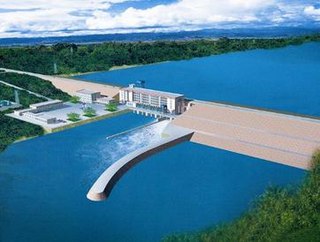 W
WThe Imboulou Dam is a dam on the Léfini River, near Ngabé, Ngabe District, Pool Department, Republic of the Congo, about 300 kilometers north of Brazzaville. It was inaugurated by President Denis Sassou-Nguesso on the 7 May 2011.
 W
WThe Keddara Dam, or Barrage Keddara, is an embankment dam 6 km (4 mi) northwest of Keddara on the Boudouaou River in Boumerdès Province, Algeria. Constructed between 1982 and 1987, the primary purpose of the dam is water supply for irrigation and municipal use in Algiers which is located 35 km (22 mi) to the west. The dam's reservoir has a capacity of 146,500,000 m3 (118,769 acre⋅ft) which is collected from drainage and the Hamiz Dam 7.6 km (5 mi) to the west and the Beni Amrane Dam 17 km (11 mi) to the east.
 W
WThe Kompienga Dam is a large hydro-electric dam in Kompienga Province in southeastern Burkina Faso. Constructed between 1985 and 1988, it is the country's first hydro-electric dam and is responsible for much of Ouagadougou's electricity supply. Visitors can obtain a permit to visit the control room of the dam from the state electricity parastatal.
 W
WThe Kossou Dam is an embankment dam that impounds the Bandama River about 32 kilometres (20 mi) northwest of Yamoussoukro in Côte d'Ivoire. It has a power generating capacity of 174 megawatts (233,000 hp), enough to power over 118,000 homes. The dam impounds the largest lake in Côte d'Ivoire, Lake Kossou.
 W
WThe Koudiat Acerdoune Dam is a gravity dam located 9.5 km (6 mi) southwest of Kadiria on the Isser River in Bouïra Province, Algeria. The dam was constructed between 2002 and 2008 with the roller-compacted concrete technique. It serves the purposes of providing water for industrial, irrigation and municipal uses. It retains a 640,000,000 m3 (518,856 acre⋅ft) capacity reservoir which supplies water for the irrigation of 20,000 ha of land along with providing the Algiers region with 178,000,000 m3 (144,307 acre⋅ft) of drinking water annually.
 W
WMaga Dam is a dam located south of Lake Chad near the border of Chad and Cameroon.
 W
WMazvikadei Dam is a dam in Zimbabwe which provides water for farm irrigation. It is the third largest dam in Zimbabwe.
 W
WMita Hills Dam is an embankment dam with a hydroelectric power station and reservoir located near Kabwe, in the Central Province of Zambia.
 W
WThe Mohamed V Dam is an arch-gravity dam located 35 kilometres (22 mi) south of Zaio on the Moulouya River in Oujda-Angad Province, Morocco. The primary purpose of the dam is supplying water for the irrigation of 70,000 hectares downstream. Water is also used for hydroelectric power production and water supply to the city of Nador. The dam is named after Mohammed V of Morocco. The dam's reservoir and wetlands were designated as a Ramsar site in 2005.
 W
WMtshabezi Dam is a reservoir on the Mtshabezi River, Zimbabwe, with a capacity of 11.4 million cubic metres. After the completion and commissioning of a pipeline linking it to Mzingwane Dam in 2013, Mtshabezi Dam became the city of Bulawayo's 6th supply dam.
 W
WThe Mulungushi Dam located 50 km south-east of Kabwe, Zambia was constructed by the Broken Hill Development Company on the Mulungushi River and opened in 1925 by the then Prince of Wales to provide hydroelectric power to the Broken Hill Mine in Kabwe. It is a sister facility to the Mita Hills Dam 60 km to its north-east. The Lunsemfwa Hydropower company currently controls the power stations of both dams and the one at Lunsemfwa Falls.
 W
WNakhla Dam is a rock-filled embankment dam in northern Morocco, to the southeast of El Hamma. The primary purpose of the dam is water supply to the city of Tetouan, 20 km (12 mi) to the south. The dam was completed in 1961 but major reinforcement works were carried out in 1968. The P4701 road passes on its western side.
 W
WThe Naute Dam is a dam outside of Keetmanshoop in the ǁKaras Region of Namibia. It was built by Concor between 1970 and 1972 and was officially commissioned in September 1972. It is the third largest dam in Namibia after Hardap Dam to Naute's north and holds up to 69 million cubic metres of water. The dam's source is the Löwen River, a tributary of the Fish River.
 W
WNyumba ya Mungu Dam is a hydroelectric dam in Tanzania. It is in Mwanga District, Kilimanjaro Region. The water runs down the slopes of Kilimanjaro in the deep valleys. These streams pour their water into the Nyumba ya Mungu Reservoir. Nyumba ya Mungu means 'House of God'. Its installed capacity is 8 megawatts (11,000 hp).
 W
WOanob Dam is a dam outside Rehoboth, Hardap Region, Namibia. Located 7 kilometres (4.3 mi) outside Rehoboth, it dams the Oanob River and provides the town with a majority of its water. It has a capacity of 34,505,000 cubic metres (1.2185×109 cu ft) and was completed in 1990, the year of Namibia's independence.
 W
WOlushandja Dam is a dam on the Etaka River outside of Oshakati in the Oshana Region of Namibia. The dam was completed in 1990. Its lake has a maximum capacity of 42.331 million cubic metres, and stores water from the Calueque Dam on the Cunene River in nearby Angola which supports the Ruacana Power Station downstream.
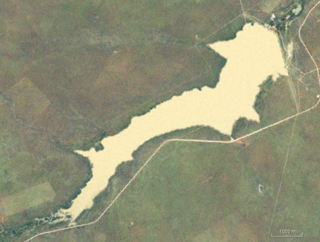 W
WOmatako Dam is an earth-fill embankment dam about 100 kilometres (62 mi) north of Okahandja in the Otjozondjupa Region of Namibia. It is named after the Omatako Mountains, and it dams the ephemeral Omatako River, with Omatako meaning "butt" in Oshiwambo, the name referring to the shape of the Omatako Mountains. The dam has a capacity of 43.49 million cubic metres (56,880,000 cu yd).
 W
WPangani Falls Dam is a dam in Tanzania, which is part of the Pangani Hydro Systems. The dam is located at Koani in the Muheza District of the Tanga Region, about 8 km south of another power station at Hale. The Pangani falls power station has two turbines and has an installed capacity of 68 megawatts (91,000 hp).
 W
WThe Roseires Dam is a dam on the Blue Nile at Ad Damazin, just upstream of the town of Er Roseires, in Sudan. It consists of a concrete buttress dam 1 km wide with a maximum height of 68 m, and an earth dam on either side. The earth dam on the eastern bank is 4 km long, and that on the western bank is 8.5 km long. The reservoir has a surface area of about 290 km2.
 W
WThe Sennar Dam is an irrigation dam on the Blue Nile near the town of Sennar in the Al Jazirah region of Sudan. The dam is 3,025 metres (9,925 ft) long and has a maximum height of 40 metres (130 ft). It was designed by the Scottish engineer Sir Murdoch MacDonald, begun in 1914 and completed in 1925 by the British contractor S Pearson & Sons.
 W
WThe Sidi el Barrak Dam is an embankment dam centred 18 km (11 mi) northeast of Tabarak and 2 km (1 mi) from the Mediterranean Sea on the Oued Zouara River in the Beja Governorate, Tunisia. Constructed between 1994 and 2000, the primary purpose of the dam is water supply. As part of the Sidi el Barrak Development Project water stored in the dam is pumped to the Seyjame Dam, at a rate of 265,000,000 m3 (214,839 acre⋅ft) annually. This water is supplied to Tunis, Cap Bon and the Sahel including Sfax for municipal use along with other agricultural purposes. The entire project was completed in 2002.
 W
WThe Sidi Salem Dam is the largest embankment dam in Tunisia located 6 kilometres (3.7 mi) northwest of Testour on the Medjerda River in Béja Governorate, Tunisia. Constructed between 1977 and 1981, the dams supplies water for irrigation and supports a 20 megawatts (27,000 hp) power station.
 W
WSmir Dam is an earth-filled embankment dam in northern Morocco, to the southeast of Nakhla Dam and 5 km (3.1 mi) west of M'diq. It is at the confluence of the Smir and El-lile wadis and has a 17 m (56 ft) saddle dam adjacent to the main dam. The primary purpose of the dam is water supply to the city of Tetouan, 12 km (7.5 mi) to the south. The dam was completed in 1991. The reservoir impounded by the dam has been designated as part of a Ramsar site since 2019.
 W
WSwakoppoort Dam is a dam 50 kilometres (31 mi) outside of Okahandja, Otjozondjupa Region, Namibia. It dams the Swakop River and occasionally receives inflow from the Omatako Dam on Swakop's tributary Omatako. Its capacity is 63.489 million cubic metres (83,040,000 cu yd). Completed in 1978, it is one of three dams to supply water to the capital Windhoek. It also supplies the Navachab mine and the town of Karibib.
 W
WTendaho Dam is an earth-filled dam in the eastern Afar Region of Ethiopia. It is situated on the Awash River, and its reservoir also receives the output of the Mille River. The dam is a project of the Ethiopian Water Works Construction Enterprise (EWWCE). Project planning began in 2005, with construction occurring from 2010 to 2014. Its purpose is to provide irrigation primarily for the Tendaho Sugar Factory sugar cane plantation., as well as drinking water for the region. Out of the 60,000 hectares of land planned to be irrigated, 10,000 would be allotted for social services and the community, while the remaining 50,000 hectares is for cultivating sugar cane for the sugar factory.
 W
WThe Thika dam is a 63 m high, 458 m crest length earthfill dam on the Thika River near Ndakaini, 50 km north of Nairobi, Kenya. The reservoir has a storage capacity of 70 million cubic meters and serves for drinking water supply. Water is treated at the Ngethu treatment works. The dam has increased the reliability of water supply to Nairobi, which suffered water shortages during the dry season before construction of the dam was completed in 1994. The dam has been financed by the African Development Bank, the World Bank, the European Investment Bank and the Kenyan government. Its construction had been delayed because of difficulties in land acquisition, leading to cost overruns. During construction the dam design has been modified to allow it to withstand a 1:10,000-year flood and to improve dam safety.
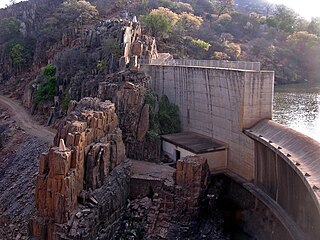 W
WThuli–Makwe Dam is a reservoir on the Thuli River, west of Gwanda, Zimbabwe with a capacity of 8.3 million cubic metres.
 W
WThuli–Manyange (Elliot) Dam is proposed a reservoir on the Thuli River, south of Gwanda, Zimbabwe with a capacity of 33 million cubic metres. It is designed to be co-operated with Thuli–Moswa Dam
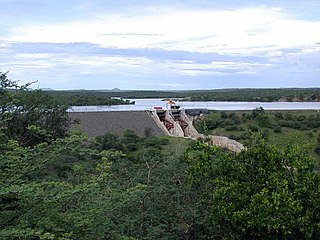 W
WThe Von Bach Dam is a rock-fill embankment dam on the Swakop River near Okahandja in the Otjozondjupa Region of Namibia. Built in 1968 and commissioned in 1970, the dam provides Namibia's capital of Windhoek with much of the city's water. It also supplies Okahandja. The dam has a capacity of 48.56 million cubic metres (63,510,000 cu yd). Water from the reservoir is sent directly to a water treatment plant downstream. The treatment plant was completed in 1971 and upgraded in 1997.
 W
WThe Wadi Ghan Dam is a rock-fill embankment dam located on Wadi Al-Hira, 14 km (9 mi) northeast of Gharyan in the Jabal al Gharbi District of Libya. Completed in 1982, the primary purpose of the dam is water supply for irrigation.
 W
WThe Wadi Kaam Dam is an embankment dam located on Wadi Kaam, 22 km (14 mi) west of Zliten in Misrata District, Libya. Completed in 1979, the primary purpose of the dam is water supply for irrigation.
 W
WThe Wadi Lebda Dam is an embankment dam located on Wadi Lebda, 5 km (3 mi) south of Khoms in the Murqub District, Libya. Completed in 1982, the primary purpose of the dam is water supply for irrigation and flood control.
 W
WThe Wadi Mejenin Dam is an embankment dam located on Wadi Mejenin, 64 km (40 mi) south of Tripoli in the Jabal al Gharbi District of Libya. Completed in 1972, the primary purpose of the dam is water supply for irrigation and flood control.
 W
WThe Wadi Wishka Dam is a concrete-face rock-fill embankment dam located on Wadi Wishka, 29 km (18 mi) southwest of Sokna in the Fezzan region of Libya. The primary purpose of the dam is flood control and water. Construction on the dam began in 2004 and it was completed in 2006 at a cost of US$5 million.
 W
WWeija Dam is a dam on the Densu River which supports the main water treatment plant for Accra in the Greater Accra Region of Ghana. It is operated by the Ghana Water Company.This supplies about 80 percent of the potable water for the entire city of Accra and its surrounding environs.